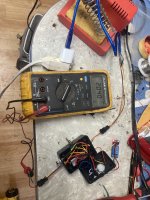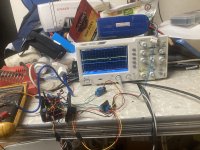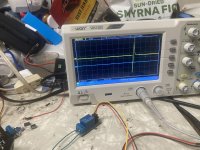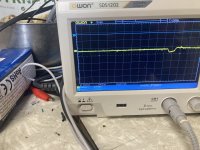I have another thread discussing Moto e-Trials design that's been going a few years.
One of the key things that's been discussed at length there is that ICE trials bikes rely heavily on flywheel inertia and torque delivery characteristics for their performance.
To date (Feb 2024) there have been no electric trials bikes that have been able to perform at the level of current stock ICE trials bikes. (The EM Factor-e prototype has just been publicly shown for the first time. It looks very promising.).
My belief is that a large part of the reason for their under-performance is lack of effective flywheel and sub-optimal torque / throttle response.
This project effectively has two parts:
This isn't the place to discuss if this is useful or not. Only how best to implement it.
Unfortunately developing the software to handle this within a controller is just not viable for a variety of reasons. Also not really open for discussion as it will only detract from getting an initial prototype device up and running.
So the plan is to build an intermediate controller (similar concept to Cycle Analyst) that will manipulate throttle signal to get the desired motor response. This should be largely independent of the controller so it's easy to try it on different controllers to find which ones respond best.
I fully intend to retain a "real" flywheel and clutch on the bike until the electronic analogy proves to be really viable.
Frankly I'm not expecting the electronic alternative to be able to fully replace the mechanical systems, I hope that it can improve power delivery and control and provide greater adjust-ability to the overall response - effectively a somewhat 'tuneable' flywheel and torque output.
The basic functions are:
There are some issues with that choice, but I think it's a reasonable compromise. Fingers crossed.
My coding skills are starting from very close to nothing and my electronics skills also. I've got a grasp of some of the fundamental concepts in both, but no practical skills or knowledge to talk of.
If anyone is interested in getting involved with this I'd be more than grateful.
I've started a GitHub project, e-trials_throttle
There's a Dev branch that I hope I can work out how to open up to collaborators. I know less about GitHub than I do writing C++ !
One of the key things that's been discussed at length there is that ICE trials bikes rely heavily on flywheel inertia and torque delivery characteristics for their performance.
To date (Feb 2024) there have been no electric trials bikes that have been able to perform at the level of current stock ICE trials bikes. (The EM Factor-e prototype has just been publicly shown for the first time. It looks very promising.).
My belief is that a large part of the reason for their under-performance is lack of effective flywheel and sub-optimal torque / throttle response.
This project effectively has two parts:
- to investigate how effective electronic "virtual flywheel" can be to modify response.
- to experiment with modifying torque delivery to more closely mimic the useful characteristics of ICE engines.
This isn't the place to discuss if this is useful or not. Only how best to implement it.
Unfortunately developing the software to handle this within a controller is just not viable for a variety of reasons. Also not really open for discussion as it will only detract from getting an initial prototype device up and running.
So the plan is to build an intermediate controller (similar concept to Cycle Analyst) that will manipulate throttle signal to get the desired motor response. This should be largely independent of the controller so it's easy to try it on different controllers to find which ones respond best.
I fully intend to retain a "real" flywheel and clutch on the bike until the electronic analogy proves to be really viable.
Frankly I'm not expecting the electronic alternative to be able to fully replace the mechanical systems, I hope that it can improve power delivery and control and provide greater adjust-ability to the overall response - effectively a somewhat 'tuneable' flywheel and torque output.
The basic functions are:
- Apply an RPM dependent variable throttle response (emulating ICE RPM/torque relationship).
- On acceleration apply smoothing to the throttle response (the controller will be set for maximum fast response).
- On deceleration apply an algorithm to emulate the decay of flywheel RPM. Initially this will disregard actual load on the drive system, so it will be fairly approximate.
- Secondary Development: Experiment with electronic clutch emulation
There are some issues with that choice, but I think it's a reasonable compromise. Fingers crossed.
My coding skills are starting from very close to nothing and my electronics skills also. I've got a grasp of some of the fundamental concepts in both, but no practical skills or knowledge to talk of.
If anyone is interested in getting involved with this I'd be more than grateful.
I've started a GitHub project, e-trials_throttle
There's a Dev branch that I hope I can work out how to open up to collaborators. I know less about GitHub than I do writing C++ !








